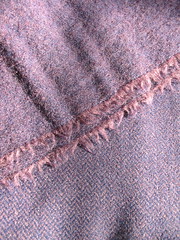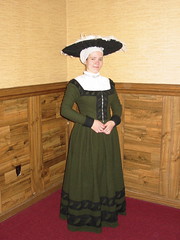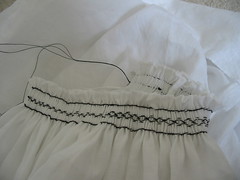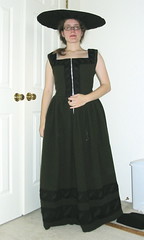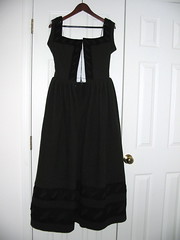My wonderful and generous sweetheart has saved me from the fabric disaster that I mentioned last time. We split a 10+ yard piece 50/50, and I washed only my part, so his is still smooth and not fulled-felted. Fortunately for me, he had no particular plans for his fabric yet, so he has offered to switch in exchange for me making him a cloak from the now thick, fuzzy stuff. So my apron dress plans are once again on track.
I should say that Norse is way out of my normal areas of expertise, but I'm learning a lot as I do the research for this project, so it should be fun. I'm planning to do a closed tube style dress, with some shaping like the Hedeby fragment. Actually, I think I'll separate out my commentary on that particular find out into a separate entry - I actually found it very difficult to produce a pattern that meshes with both the details of that find and other contemporary evidence and general knowledge of clothing construction. What I came up with is probably not original, I'm sure someone's done it before, but I'm happy with it and it's a bit different from what I see most commonly in recreations.
I also picked up some additional very nice fabric from the liquidation sale at one of my local Hancock Fabrics. (Many but not all locations are being closed - there's decent discounts on notions, and fabrics if you get lucky.) I got 2 yards of a lightweight wool in a cream color - I'm thinking that I might experiment a bit with wool veils, and see how they work, and also 6 yards of grey wool in the most summer of summer weights that I've ever had the pleasure to find. The color is not ideal, so I don't know what I'll do with it yet, but the weight and hand were so gorgeous that I couldn't just leave it there. Based on drape I think it would be excellent as a full-on court bliaut, but I'm having a hard time imagining doing such a high-status garment in such nondescript color. (And I'm not keen on the idea of dying it - evenness has always been a major problem for me when I attempt that.)
12 April 2007
02 April 2007
Calm before the storm
My sewing room has been rather quiet for the last month, but I've been making plans for the new season. I've made a list of things I want to make this year, and it's a long one! Hopefully, real life won't interfere too much, although it's threatening.
Top on my list is more low-maintenance clothes for camping events this summer - simple linen tunic-dresses mostly, and a lot more stockings, as I've destroyed most of mine over the past couple years. I'd also like to do an apron-dress and pull together some Norse-appropriate accessories to dress up some of those tunic dresses a bit - probably aiming for the late end of that era.
Then I've got big plans for a new court dress - the blue dress from the April calendar page of Les Très Riches Heures du Duc de Berry. I've got a navy silk-faced satin brocade with gold fleur-de-lys, which I think should be about perfect. Unfortunately, the gold is poly, which means that the fabric is entirely and heavily backed with polyester, but I doubt I'll ever find anything better. I'm not completely sure what I'll use for the lining/contrast yet, but I do have plenty of white silk broadcloth that might work. Of course, I'll need to do a long sleeve cote first, to fit it over, which is just as well. I've been meaning to for years, but I still haven't made a long-sleeved layer to do late 14th c. stuff.
As a side project, I'd like to really finish my Persian ensemble. The coats are essentially fine (although one needs loops or buttonholes or something to go with its buttons), but I still need to make a pirahan (chemise-type layer), salwar (pants), and a hat. The pirahan will probably be white lightweight linen, which I always have on hand, but I'd need to find fabric for the salwar. The hat would be the style that Roxane Farabi calls a broom hat, which should be pretty simple once I figure out what kind of feather to use. (Incidentally, the look and color scheme of my coats is very similar to the figure in the lower left of the first picture at that link.)
If all that wasn't enough, I've also got a mid 14th c. gown with proto-tippets in the back of my head. Plus a bunch of mending and finishing on projects that should have been done by now. And I should probably make some clothes for my guy, since he's not likely to get around to doing it himself.
The picture above is the fabric I had intended to use for that Norse apron dress, before and after washing. (Note that the colors are mangled - it's actually purple and navy, and rather dark at that.) I hadn't expected it to react that badly to water, and sadly I threw my whole piece in (the remaining piece belongs to the guy, since we went in on the purchase). I don't know what I'll be doing with it now, since it doesn't seem at all appropriate for what I had planned. There's a lesson here about always washing a test swatch first, even if you think you know how it'll behave, and it's a lesson I really should have learned by now. Hopefully I'll remember this (rather expensive!) mistake next time : (
Top on my list is more low-maintenance clothes for camping events this summer - simple linen tunic-dresses mostly, and a lot more stockings, as I've destroyed most of mine over the past couple years. I'd also like to do an apron-dress and pull together some Norse-appropriate accessories to dress up some of those tunic dresses a bit - probably aiming for the late end of that era.
Then I've got big plans for a new court dress - the blue dress from the April calendar page of Les Très Riches Heures du Duc de Berry. I've got a navy silk-faced satin brocade with gold fleur-de-lys, which I think should be about perfect. Unfortunately, the gold is poly, which means that the fabric is entirely and heavily backed with polyester, but I doubt I'll ever find anything better. I'm not completely sure what I'll use for the lining/contrast yet, but I do have plenty of white silk broadcloth that might work. Of course, I'll need to do a long sleeve cote first, to fit it over, which is just as well. I've been meaning to for years, but I still haven't made a long-sleeved layer to do late 14th c. stuff.
As a side project, I'd like to really finish my Persian ensemble. The coats are essentially fine (although one needs loops or buttonholes or something to go with its buttons), but I still need to make a pirahan (chemise-type layer), salwar (pants), and a hat. The pirahan will probably be white lightweight linen, which I always have on hand, but I'd need to find fabric for the salwar. The hat would be the style that Roxane Farabi calls a broom hat, which should be pretty simple once I figure out what kind of feather to use. (Incidentally, the look and color scheme of my coats is very similar to the figure in the lower left of the first picture at that link.)
If all that wasn't enough, I've also got a mid 14th c. gown with proto-tippets in the back of my head. Plus a bunch of mending and finishing on projects that should have been done by now. And I should probably make some clothes for my guy, since he's not likely to get around to doing it himself.
The picture above is the fabric I had intended to use for that Norse apron dress, before and after washing. (Note that the colors are mangled - it's actually purple and navy, and rather dark at that.) I hadn't expected it to react that badly to water, and sadly I threw my whole piece in (the remaining piece belongs to the guy, since we went in on the purchase). I don't know what I'll be doing with it now, since it doesn't seem at all appropriate for what I had planned. There's a lesson here about always washing a test swatch first, even if you think you know how it'll behave, and it's a lesson I really should have learned by now. Hopefully I'll remember this (rather expensive!) mistake next time : (
Labels:
15th c.,
general,
Très Riches Heures gown
05 March 2007
Finished Kampfrau gown
This is my finished early 16th c. German common woman's outfit. I'm very pleased with how everything turned out. Gown is heavy wool and trimmed in a lighter wool, with bodice lined and interlined in linen; sewn with silk and some linen thread and closes with hooks and eyes. Hemd (chemise) is lightweight linen, sewn with linen and smocked with black silk embroidery thread; closes with two pairs of hooks and eyes at the neck. Hat is wool bedecked in ostrich feathers, shape held by 8 gauge copper wire. The set-up under the hat is a fine example of last-minute materials-on-hand costuming - I'm using a couple of skeins of wool yarn to create the wulst bulge (fake braids would be preferable - easier to arrange and less squishy) and the veil over it is neither the right size or shape (but workable with enough pins and patience). The gown and hat used patterns from Reconstructing History; the chemise is my own design.
Labels:
16th c.,
Green Kampfrau gown,
showcase
18 February 2007
In which Catrijn learns to smock
This is the hemd (chemise, shift, whatever) I'm working on to go with the green and black kampfrau gown. I've got a little under a week to get everything finished and ready to go, and it looks like I'll make it. The gown itself is finished and I've got feathers on my hat, so all that's left is this, and it mostly just needs seam finishing and hemming.
This is the first time I've done smocking, and it seems to be turning out all right. (I'm very much a learn by doing type of person.) My main reference for this was a book called The Art of Manipulating Fabric. It's a manual on a lot of very interesting techniques for shaping flat fabric into objects with volume and texture. Most of the stuff is not particularly useful for garment sewing, but some is, and it's all fun to look at. Anyway, I did three rows of gathering (dot pick-up on a 1/2 inch grid) using polyester upholstery thread (strong and slides easily). The smocking itself is done in a silk embroidery thread.
The biggest problems I had were with tension (I was nervous about pulling too tight when I started, which of course meant that things ended up much too loose) and trying to get the finished result to a particular size (in this case, to match my neck). The gathering threads are tied off at the correct length, but the smocking would relax to a longer length if they were cut out (like they would normally be) so I might need to leave them in. Either that, or go back and add additional tighter rows to stabilize it. I also need to figure out what I'm going to do for closure on it. Maybe a pair of ties at the top and bottom edge, tacked down to the first half inch or so of pleats?
This is the first time I've done smocking, and it seems to be turning out all right. (I'm very much a learn by doing type of person.) My main reference for this was a book called The Art of Manipulating Fabric. It's a manual on a lot of very interesting techniques for shaping flat fabric into objects with volume and texture. Most of the stuff is not particularly useful for garment sewing, but some is, and it's all fun to look at. Anyway, I did three rows of gathering (dot pick-up on a 1/2 inch grid) using polyester upholstery thread (strong and slides easily). The smocking itself is done in a silk embroidery thread.
The biggest problems I had were with tension (I was nervous about pulling too tight when I started, which of course meant that things ended up much too loose) and trying to get the finished result to a particular size (in this case, to match my neck). The gathering threads are tied off at the correct length, but the smocking would relax to a longer length if they were cut out (like they would normally be) so I might need to leave them in. Either that, or go back and add additional tighter rows to stabilize it. I also need to figure out what I'm going to do for closure on it. Maybe a pair of ties at the top and bottom edge, tacked down to the first half inch or so of pleats?
Labels:
16th c.,
Green Kampfrau gown,
smocking,
techniques
08 January 2007
Modelling the in-progress Kampfrau gown
I finally got enough hooks and eyes onto the dress to model it. Actually, I ran out of hooks and eyes just above waist level, which is why I'm holding the rest of the opening closed. There's a photo of the back here. What remains to be done is attaching the skirt permanently (it is just pinned now) and sleeves, obviously. Actually I must say that I really like this as a sleeveless gown - I'm thinking that some time I might want to make one in a lighter weight wool for summer wear, like this woodcut of a seamstress. Sure, it's a very rare style, but my main pursuit in the SCA is as a seamstress, so it's not too inappropriate.
This does serve to illustrate why I don't like hooks and eyes as a closure mechanism for non-overlapping edges, but in this case I couldn't think of a better way to do it. The gapping is perfectly even, so it's not like I've set them too far apart, it's just that the edges curl out a little. I've already tacked down the ends of the hooks, or else it would be much worse, and I'm thinking I may try to tack down more of the eyes as well. If that doesn't fix it, I may resign myself to basting the opening closed when I wear it.
As you can see, I also started the hat. It's made of basically the same wool fabric as the guards, but with the non-napped side out instead. If you're working from Reconstructing History pattern 505 (German accessories) be careful when you cut the underside piece - it needs to be 70-75 inches long to go all the way around (same measurement as you need of wire) - on my copy of the pattern, at least, the printed piece is only half that long (18x7.5 inches, cut on fold for total length of 36 inches). As for wire, I used 8 gauge solid copper wire from Home Depot (it's in electrical on the cut to order spools; you'll need to get an employee to measure it off for you, just like at the fabric store). It's very sturdy (possibly overkill, but I'm okay with that). Now I just need to obtain feathers. Sure, you see some hats that are just plain, but I really enjoy going all out : )
This does serve to illustrate why I don't like hooks and eyes as a closure mechanism for non-overlapping edges, but in this case I couldn't think of a better way to do it. The gapping is perfectly even, so it's not like I've set them too far apart, it's just that the edges curl out a little. I've already tacked down the ends of the hooks, or else it would be much worse, and I'm thinking I may try to tack down more of the eyes as well. If that doesn't fix it, I may resign myself to basting the opening closed when I wear it.
As you can see, I also started the hat. It's made of basically the same wool fabric as the guards, but with the non-napped side out instead. If you're working from Reconstructing History pattern 505 (German accessories) be careful when you cut the underside piece - it needs to be 70-75 inches long to go all the way around (same measurement as you need of wire) - on my copy of the pattern, at least, the printed piece is only half that long (18x7.5 inches, cut on fold for total length of 36 inches). As for wire, I used 8 gauge solid copper wire from Home Depot (it's in electrical on the cut to order spools; you'll need to get an employee to measure it off for you, just like at the fabric store). It's very sturdy (possibly overkill, but I'm okay with that). Now I just need to obtain feathers. Sure, you see some hats that are just plain, but I really enjoy going all out : )
30 December 2006
Kampfrau gown assembly
I've sewn all the pleats down onto the linen tape, and then pinned the whole thing onto the bodice to re-check fit. I apparently drafted the bodice a bit too long-waisted, and had to move the skirts about an inch higher than expected. It's just as well, because the bottom edge otherwise would have needed to be shortened. The extra-wide seam allowance is nice too, because it looks like I'll need to tack the backside of the pleats down to it in order to keep the seam allowance pointing down rather than up. I think I need to put in most of the hooks and eyes so I can actually try it on properly before I actually sew the waist seam, since it's hard to tell how high or low the center front will hang when you're just holding the edges together with your hands while you're wearing it.
Obviously, I don't have a dress form, so it's a little hard to set gowns up for display or photography. I almost bought one this week, but they are expensive, and I spent my money on fabric instead. (6 yards silk-faced brocade, navy blue with gold fleur-de-lis!) Once the front closure is ready, I can hopefully get some pictures with me modeling it.
Obviously, I don't have a dress form, so it's a little hard to set gowns up for display or photography. I almost bought one this week, but they are expensive, and I spent my money on fabric instead. (6 yards silk-faced brocade, navy blue with gold fleur-de-lis!) Once the front closure is ready, I can hopefully get some pictures with me modeling it.
Subscribe to:
Posts (Atom)
